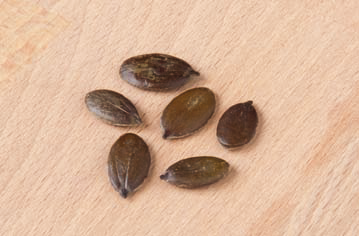
 Take a few seeds and observe them. At first the external shape can be experienced. This observation can now be followed by the idea that in these seeds the specific plant is already contained as an archetype. Step by step, in the following picturing-process, like logical imagining, further possibilities can be thought: The seed-pod dies and the germ grows. But the germ also dies and a first root and stem structure emerges. Finally, however, this also recedes again, and there emerges a still further-forming leaf, flower and fruit-structure. Once, in the last stage of a cycle, the seeds develop again, the plant usually dies away completely.
Take a few seeds and observe them. At first the external shape can be experienced. This observation can now be followed by the idea that in these seeds the specific plant is already contained as an archetype. Step by step, in the following picturing-process, like logical imagining, further possibilities can be thought: The seed-pod dies and the germ grows. But the germ also dies and a first root and stem structure emerges. Finally, however, this also recedes again, and there emerges a still further-forming leaf, flower and fruit-structure. Once, in the last stage of a cycle, the seeds develop again, the plant usually dies away completely.
With these contemplative and pictorially imagined considerations, the activity of the life ether can be grasped for the first time. A feeling of calmness becomes perceptible with this exercise for one who does it with concentration.
Life ether
The life ether develops likewise with a polarity which can best be described as descent and ascent. While one force moves downwards as if dying, a new movement rises up like a flame.
All ethers are usually experienced like flame forms, which however complement each other. Materially seen, from a purely external consciousness one would perceive these movements as contradictory. In the ether, which acts free from gravity, however, the principles prevail, that precisely contradictory aspects complement each other in the sense of a counter-movement. When, therefore, a movement descends downwards, at the same time something like a new movement-form or flame-form begins to ascend upwards.

Note:
This process of dying on the one hand, and of new formation on the other, even begins to show for example in scientific observation, because the foliage, flowers, fruits and some of the plant’s cell types age and die faster than the plant as a whole. Tissues with the ability to divide in embryonic growth zones, on the other hand, remain with the plant throughout its life, so that new parts are constantly being shaped. At the outermost periphery, at the tips of roots and young leaves, and at some specific sections of the stem, the tissues always remain soft and actively dividing, while other parts lignify or disconnect from the whole. Observations under the microscope also show processes of new-formation and dying, which are dependent on each other. Scientific research, therefore, need not necessarily be considered in isolation from the esoteric vision of dying and rising up anew.
Translator’s note:
In order to remain as close as possible to the original German text, the word ‘he’ has been used to refer to people in general, both men and women.
The word “Empfindung” has mainly been translated with the term “sensitive feeling”